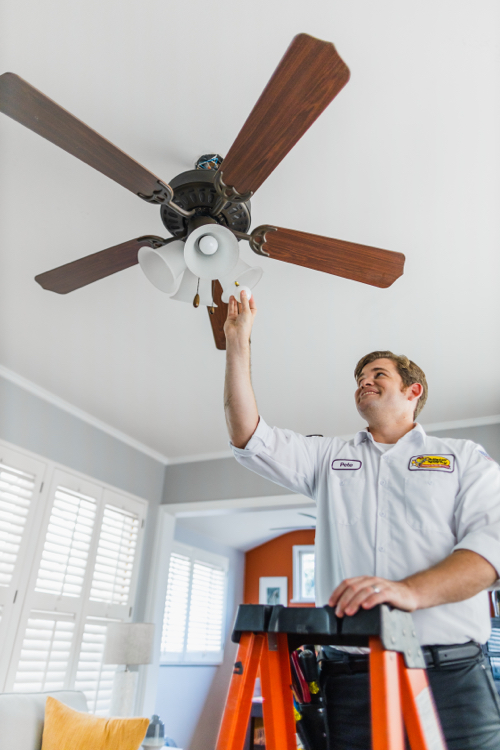Picking the Perfect Ceiling Fan Size: Let’s Make This Easy!
Ceiling fans are more than just functional; they add comfort and style to your home. Yet, one simple factor can make or break your experience size. Choosing the right size ceiling fan isn’t just about aesthetics. It’s about efficiency, comfort, and practicality. If you’ve found yourself scratching your head over which size to pick, you’re in the right place!
This guide will walk you through everything you need to know about selecting the perfect ceiling fan size for any room. By the end, you’ll not only feel confident in your choice, but your home will also feel better equipped for comfort and energy savings.
Why Size Matters When Choosing a Ceiling Fan
Imagine a ceiling fan spinning tirelessly in your living room, yet the air feels almost static. Or worse a fan that’s too large, overpowering your cozy space. This is what happens when the size isn’t quite right.
A ceiling fan’s size directly affects:
- Airflow efficiency: Fans too small won’t distribute air effectively, while oversized fans can create excessive drafts.
- Room aesthetics: A well-sized fan complements a room; a poorly sized one can stand out for all the wrong reasons.
- Energy consumption: The right fan size optimizes energy use, saving you money on utility bills.
The good news? Finding the best fit isn’t complicated once you understand a few key measurements.
Measure Your Room to Determine Fan Size
Room dimensions are the foundation of picking the right fan. Here’s the step-by-step breakdown:
Step 1: Measure the Room’s Square Footage
Use a tape measure to determine the length and width of your room. Multiply these two numbers to calculate the square footage. For example:
A room that’s 12 feet wide by 14 feet long has an area of 168 square feet (12 x 14 = 168).
Step 2: Focus on Ceiling Height
Ceiling height plays a crucial role in functionality. A fan installed too high won’t circulate air properly; one placed too low can pose safety concerns.
For ceilings below 8 feet, consider flush-mount or “hugger” fans to keep them closer to the ceiling.
For ceilings 9 feet or higher, you’ll likely need a downrod to lower the fan to an optimal height.
Step 3: Establish the Right Sweep Size
The sweep size, or blade span, is arguably the most critical factor. This measurement refers to the diameter of the circle the blades create while spinning.
Room Size Guide for Ceiling Fan Blade Span
Here’s a quick reference chart to help you match fan sizes to your room area:
Room Size (Up to 75 sq. ft.): Fan Blade Span = 29–36 inchesExamples: Small bathrooms, laundry rooms
Room Size (76–144 sq. ft.): Fan Blade Span = 36–42 inches
Examples: Guest bedrooms, home offices
Room Size (145–225 sq. ft.): Fan Blade Span = 44–50 inches
Examples: Master bedrooms, living rooms
Room Size (226–400 sq. ft. or larger): Fan Blade Span = 50–60 inches
Examples: Open-concept spaces, large family rooms
For rooms with unconventional layouts, look at the longest wall as your reference point.
Additional Factors to Keep in Mind
While square footage and blade span are essential, a few extra considerations can further refine your choice.
- Blade Angle & Airflow
- Blade pitch (angle) affects how much air the fan can push. For optimal results:
Choose fans with blade pitches between 12° and 15° for good airflow.
Fans with flatter blades or lower angles might need to spin faster to be effective, which can increase noise.
Number of Fans for Larger Spaces
If your space exceeds 400 square feet, a single fan may not be enough. Instead of choosing an oversized fan, install two medium-sized fans for balanced airflow. For instance, in a long dining room or open-concept kitchen, one fan near each end could be more functional and visually balanced.
Ceiling Fan Placement
Positioning is just as critical as size. Ideally, the center of the fan should align with the center of the room. This placement ensures even air circulation. When furniture or architectural features create asymmetry, aim to position the fan directly over the most-used area. For vaulted or angled ceilings, ensure your fan is compatible with a slope mount system.
Room-by-Room Considerations for Ceiling Fans
Because no two rooms are the same, here’s a closer look at how to apply these tips across various spaces in your home:
Living Rooms & Family Rooms
These spaces often accommodate groups, so a larger fan (50–60 inches) is your best bet. If the layout is irregular, consider dual fans on opposite ends.
Bedrooms
Ceiling fans in bedrooms keep you cool and relaxed. A 44–50 inch fan works well in most standard bedrooms but ensure the fan operates quietly for an undisturbed sleep.
Kitchens
Kitchens can get hot and stuffy, especially near cooking areas. For smaller kitchens (less than 150 sq. ft.), consider compact fans with around 36-inch blade spans. Install your fan away from open flames or stovetops.
Outdoor Patios
Fans in outdoor areas like patios or verandas should be both size-appropriate and weather-resistant. Look for fans labeled as wet-rated or damp-rated, depending on your climate.
Technology to Enhance Your Ceiling Fan Experience
Modern ceiling fans go beyond cooling and circulation.
Many options now include advanced features that make life easier:
- Remote Controls: Adjust speed and lighting without leaving your seat.
- Smart Home Integration: Some fans connect to Wi-Fi and apps, allowing you to control them via voice commands or smartphone.
- Energy-Efficient Models: Look for ENERGY STAR-rated fans for maximum savings.
- Reversible Blades: Use reverse mode in winter to push warm air downward, improving heating efficiency.
These features add customization and convenience, making your ceiling fan work smarter in every season.
Final Checks Before Buying
Once you’ve narrowed down your options, do a final review:
- Safety Certification: Make sure the fan complies with safety standards, especially for outdoor or wet areas.
- Warranty Coverage: Look for products with solid warranties to safeguard your investment.
- Material & Finish: Choose finishes and materials that complement your room’s décor while meeting functional needs.
Elevate Your Cooling & Comfort
Selecting the right ceiling fan size may seem trivial, but it holds the key to practical, energy-efficient comfort. By measuring your space, assessing features, and understanding your needs, you can make an informed decision that improves both function and aesthetics.
Whether you’re refreshing one room or all of them, remember these steps the next time you shop. Stay comfortable, save energy, and enjoy the breezy benefits of a well-sized fan in your home.
